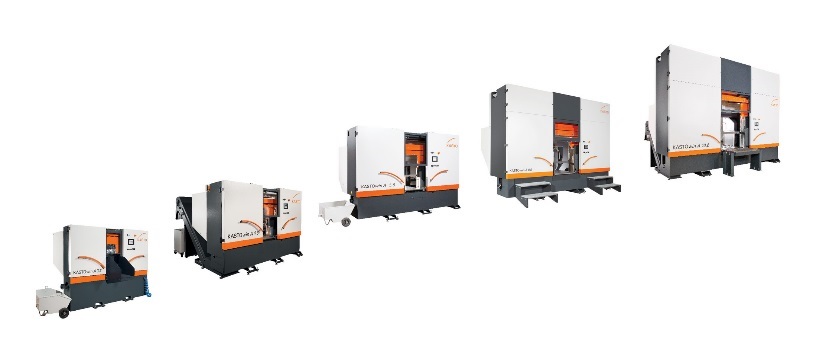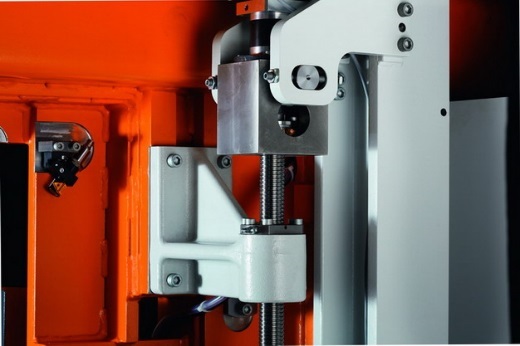An example in sawing technology: Electricity-saving measures are only worthwhile provided they are not implemented at the expense of efficiency. KASTO Maschinenbau GmbH has paid particular attention to this when developing its new KASTOwin series. This resulted in an extremely efficient band-sawing machine that allows the operator to make significant savings, without compromising on cutting performance.
Increasing cost pressure, tough international competition and ever-increasing customer demands mean metal-processing companies are facing significant challenges: On the one hand, it is important to be able to flexibly offer more and more different materials and sizes of the highest quality, and from a batch size of one through to series production. On the other hand, the unit costs must be low and competitive so that in-house production is economically viable. Finding a happy medium is a difficult task faced by many operators.
Sawing technology is also continuing to develop against this backdrop. As tasks become more complex, the requirements placed on machine manufacturers also increase: Automatic saws must meet diverse criteria, such as offering high cutting performance, a wide range of applications, minimal idle times, perfect cutting results, high repeatability, ease of use and effective material use. In times of increasing energy costs and ever-longer daily periods of use, efficiency also plays a key role. The power consumption of a sawing machine used during a single shift can have a considerable influence on operating costs – and the costs are all the higher for two or more shifts.
But not every measure that improves a machine’s energy efficiency is suitable for the user: “These ideas often come at the expense of production capacity,” explains Matthias Eigbrecht, Head of the Electrical Design department at KASTO Maschinenbau GmbH & Co. KG. By launching the KASTOwin, the metal sawing machine manufacturer has developed a product range that is not only industry-leading thanks to its diverse areas of application and high cutting performance, but also offers incomparably low energy consumption. “In designing the new series, our aim was to develop a cost-efficient solution that does not compromise on function yet still meets all our customers’ requirements – and at the right price,” Mr Eigbrecht explains.
Pragmatic developments
A thorough analysis of all the energy-consuming machine elements and their corresponding power requirements was the basis for the development work. Using the results, KASTO developed a series of concepts that would allow energy to be saved in different areas. “We then evaluated these concepts from a commercial viewpoint; in other words, we weighed the increased cost of the investment against the possible operating savings,” says Mr Eigbrecht. “In doing so, we determined certain measures to be meaningful but others less so – and we then rejected the latter.” However, a few points still needed to be addressed, allowing KASTO to significantly improve the energy efficiency of the new series.
The greatest potential lay in the hydraulics system, which is responsible for a significant proportion of the sawing machine’s energy consumption. Initially, KASTO tested and compared equipment from different manufacturers and opted for the most efficient. To complement this, the KASTOwin engineers developed an electromechanical saw downfeed. The hydraulics system is now only responsible for workpiece clamping and saw blade tensioning, meaning it therefore needs to be actuated far less than in the past. “As a result, we were able to reduce the machine’s overall energy consumption by around 30 per cent,” reports Mr Eigbrecht.
Modern drive technology uses energy intelligently
For the saw motors, KASTO uses frequency-controlled drives of efficiency class IE3. As a result, cutting speeds of twelve to 150 meters per minute can be achieved. At the same time, the motors are compact and extremely efficient. Modern servo drives are also used for the material infeed and saw downfeed. Linear guides and ball screw spindles ensure highly efficient, precise power transmission. Users therefore not only benefit from exact and repeatable sawing results, but also from low energy requirements.
All drives are controlled by intelligent converter technology. KASTO has fitted the frequency converter with a DC link: Excess energy, which is generated when braking the saw motor for example, can therefore be recovered and used elsewhere in the system. In contrast, conventional technology disperses this energy via brake resistance, so it is lost as heat. “Our solution, however, optimally uses synergy effects and significantly lowers the saw’s energy consumption,” explains Mr Eigbrecht. KASTO has been successfully using DC links in its automatic storage systems for a long time.
KASTO engineers have also turned their attention to the weight of the sawing machines – after all, the more weight that needs to be moved for each cut, the more energy is required. Using new methods, dynamic parts such as the saw frame have been designed to be lighter, without having to compromise on vibration damping or quiet operation.
Rapid payback
Overall, these various improvements have made it possible to achieve significant improvements in the energy efficiency of KASTOwin bandsaws. Depending on the sawing task, energy consumption is on average almost 30 per cent lower compared with similar previous models. Depending on operating times, operators can reduce their annual operating costs by several hundred euros. Productivity is unaffected – “after all, we base our development work on our customers’ needs first and foremost,” explains Mr Eigbrecht. The KASTOwin series offers high cutting performance and optimum results in different applications across various industry sectors. And the saw also stands out from an economic point of view: Thanks to its excellent value for money, the investment is often recouped in a very short time. The components are included in the standard version.

When developing the KASTOwin series, KASTO paid particular attention to optimum energy efficiency.

The aim was to develop a cost-efficient solution that does not compromise on function yet still meets all requirements – and at the right price.

Modern servo drives are used for the material infeed and saw downfeed. Linear guideways and ball screws ensure highly efficient, precise power transmission.
NIKE AIR MAX













